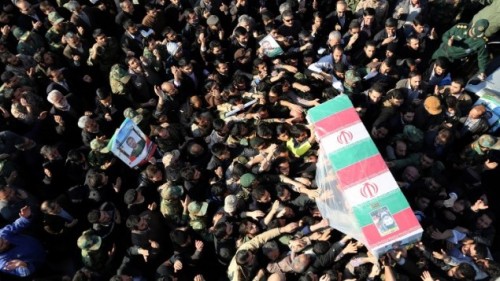PHOTO: Funeral of General Mohammad Ali Allahdadi, killed by Israeli airstrike inside Syria in January (Atta Kenare/AFP)
Majid Mohammadi writes for al-Araby al-Jadeed:
The Islamic Republic of Iran has officially and repeatedly denied any involvement in military intervention in the Syrian civil conflict.
Nevertheless, official and semi-official Iranian news agencies such as Fars News and Tasnim — both reportedly owned or sponsored by the Revolutionary Guards — have published lists of Iranians “martyred” in Syria.
Other than a few names and burial locations, there is little information about those killed.
Based on the details available, we are able to draw three conclusions:
*The dead soldiers come from all over the country. This means it is likely that multiple battalions have been deployed.
*Some of the names provided are aliases (real names included in parenthesis in reports). This means some of those reportedly killed in Syria are likely to be related to intelligence agencies — people who work for the Republican Guard intelligence units or the Intelligence Ministry often have multiple names.
*The “martyrs” are covered under the banner of “defenders of haram (Zaynab or Roghayyeh)”, implying they had gone to Syria to defend Shia mausoleums – and not the Assad regime. This is how the deployment is being sold to the Iranian public, and casualties are sanctioned.
An Official Silence
Iranian politicians have largely remained silent about casualty figures, although they have expressed their total and unconditional support for the Assad regime.
Iran’s foreign minister, Javad Zarif, said it would be an “illusion” to think that the Syria crisis could be settled without President Bashar al-Assad.
Aside from the official policy of censorship, news websites and militia members have frequently spoken of “our young people in Syria”.
“Their pure bodies are back in the country”, says one, while “his coffin was carried by the people to his grave”, says another. They are dubbed “martyrs of Syrian Islamic resistance… killed by Wahhabi terrorists”.
No one in the country has been able to express discomfort at the sight of mothers and fathers weeping at their sons’ graves or soldiers nuzzling the heads of their children before they ship out for Syria.
Unlike the years of the Iran-Iraq war, Iranians are not able to watch military personnel departing from the home front, clasping their mothers, spouses and children in emotional last-minute embraces.
No images of coffins have been disclosed. No images have flashed on Iranian television screens or splashed across newspaper front pages.
Iranian leaders have never held a national address to talk about the deployed or fallen soldiers in Syria. Nobody is allowed to raise uneasy questions about the deployment, or to highlight opinions about the place of Iranians in the Syrian conflict.
No statistics have been reported about the number of soldiers deployed or killed. Nobody can ask the fundamental question: “Was the country ready for
The Costs of Denial
The whole government is in a state of denial. There has not been any recognition of the anguish that men experience as they go off to war and leave spouses and children behind.
There has been no acknowledgement of the spouses who have been left to cope as single parents with the very real physical and emotional aspects of running a household and tending to the children.
There has not been any nuanced delineation of how men actually feel facing their fear of battle amid people who do not speak their language and fighting for a regime that has killed more than a hundred thousand of its own people.
There is not even one official report about how much Iran pays the Syrian regime, or the quantities of Iranian weapons shipped to Syria.
What the public has seen are images and videos taken by the Syrian opposition and broadcast by the VOA Persian or BBC Persian TV channels.
There has been no military draft for this intervention and no drafted soldier has been sent to this war.
Iran sends trained IRGC members who volunteer for this conflict on good pay. At the same time, Foreign Minister Zarif condemns any possible “foreign” military intervention in Syria — as if Iran is not already doing so.
Due to this denial, Iranian soldiers who have been wounded in the Syrian conflict or are dealing with PTSD have no way of getting help from society around them, or healing through traditional processes of public honouring of sacrifices and story-telling.
“Little Choice Except to Keep Assad in Power
Iran’s support for the Syrian regime has reached the point that it has reportedly been asked to establish a fund to pay pensions to the families of Syrian soldiers killed in the conflict. Iran is thought to have trained 300,000 Syrian nationals — 150,000 in Syria and 150,000 in Iran – and has provided logistical support for 50,000 Lebanese Hizballah fighters, according to Mahmood Nabavian, an Iranian member of parliament speaking last year.
To guarantee Hezbollah’s military supply lines, the consolidation of the Shia regional alliance in the region, and to protect Iran’s investments in Syria, Tehran has little choice other than to keep Assad in power.
This has inflicted economic, political, and moral costs on Iran’s rulers, in addition to the mounting casualty toll.
Iran is understood to give free oil to Syria, lending millions of dollars that will never be repaid, and pay for thousands of Hezbollah fighters deployed in Syria.
Tehran has tried hard to represent itself as a unifying force in the Muslim world, while the Syrian conflict is largely built on sectarian divisions. Each and every week, Iranian Shia are killed in Iraq, Syria and Lebanon by Sunni fighters — and vice versa.

